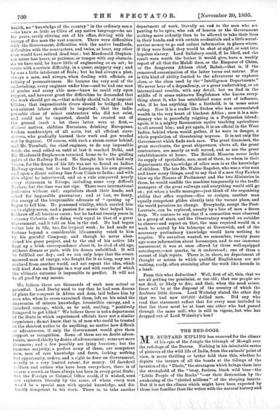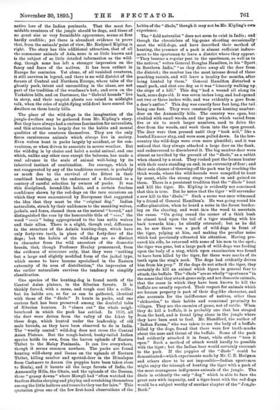THE RED-DOGS.
"VTR. RUDYARD KIPLING has reserved for the climax of his epic of the Jungle the triumph of Mowgli over the red-dogs of the Deccan. Nothing in his inimitable series of pictures of the wild life of India, from the animals' point of view, is more thrilling or better told than this, whether he depicts the terrors of all the beasts at the tidings of the invasion of the " Dhole," the stratagem which brings them into the stronghold of the "busy, furious, black wild bees—the Little People of the Rocks' "—or their destruction by the awakening of the "clotted millions" of the sleeping insects. But it is not the climax which might have been expected by those less familiar than the writer with the natural history and
native lore of the Indian peninsula. That the most for- midable creatures of the jungle should be dogs, and these of no great size or very formidable appearance, seems at first hardly credible ; yet there is abundant evidence to prove that, from the animals' point of view, Mr. Rutlyard Kipling is right. The story has this additional attraction, that of all the commoner animals of Asia, none is so little known and is the subject of so little detailed information as the wild- dog, though none has left a stronger impression on the fancy and fears of the natives. It has been extinct in Europe for centuries. Yet alone, of all vanished creatures, it still survives in legend, and there is no wild district of the forests of Central and Northern Europe, where tales of the ghostly pack, intent and unremitting in the chase, are not part of the tradition of the woodman's hut; and even on the Yorkshire hills, and on Dartmoor, the "Gabriel hounds" live in story, and their unquiet ghosts are raised in midnight talk, when the cries of night-flying wild-fowl have scared the dwellers on these lonely bills.
The place of the wild-dogs in the imagination of the jungle-dwellers may be gathered from Mr. Kipling's story. But they have always had a curious fascination for naturalists, and this attraction is largely due to the habits and mental qualities of the creatures themselves. They are the only fierce carnivorous animals which always live in society. Even wolves hunt in packs largely by accident, or for con- venience, or when driven to associate in severe weather. But the wild-dog is by choice and habit a social animal, and one which, unlike any other race except the baboons, has made a real advance in the scale of animal well-being by its inherited instinct of combination. Its courage, which is not exaggerated by any of the traditions current, is probably as much due to the survival of the fittest in their combined hunting, as the endurance of a foxhound to a century of careful selection by owners of packs. It was this disciplined, hound-like habit, and a certain fearless confidence shown by the red-dogs on the rare occasions on which they were encountered by Europeans that suggested the idea that they must be the "original dog." Indian naturalists, struck by their unlikeness to the sneaking wolves, jackals, and foxes, classed them as the natural "hound," and distinguished the race by the honourable title of " et;c4y," the word " califs " being appropriated to the less noble wolves and their allies. There is a slight, though real, difference in the structure of the Asiatic hunting-dogs, which have only forty-two teeth, in place of the forty-four of the dogs; but the habits of the wild-dogs are so distinct in character from the wild ancestors of the domebtie breeds, that, though Professor Huxley pronounced, from the evidence of structure only, that they were " nothing but a large and slightly modified form of the jackal type, which seems to have become specialised in the Eastern extremity of its area of distribution," the impression of the earlier naturalists survives the tendency to simplify classification.
One species of the hunting-dog is found north of the Central Asian plateau, in the Siberian forests. It is thickly furred, with a mane, and rough coat like a collie ; but its habits are, so far as can be gathered, identical with those of the "dhole." It hunts in packs, and one curious fact has been preserved among the doubtful tales of Siberian hunters. It "clears out" the whole neigh- bourhood in which the pack has settled. In 7859, all the deer were driven from the valley of the Irkut by these dogs, which hunted under the leadership of old male hounds, as they have been observed to do in India. The "woolly coated". wild-dog does not cross the Central Asian Plateau. But the rough-haired, bushy-tailed Indian species holds its own, from the barren uplands of Eastern Thibet to the Malay Peninsula It can live everywhere, though it seems common nowhere. The packs are found hunting wild-sheep and ibexes on the uplands of Eastern Thibet, killing sambur and spotted-deer in the Himalayas from Cashmere to Assam (its puppies have been taken close to Simla), and it haunts all the large forests of India, the Annamully Hills, the Ghats, and the uplands of the Deccan, those "grassy downs" where Mowgli had "often watched the fearless dholes sleeping and playing and scratching themselves among the little hollows and tussocks they use for lairs." This quotation gives one of the few first-hand observations of the habits of the" dhole," though it may not be Mr. Kipling's own experience.
The "field naturalist" does not seem to exist in India; and ' though the chroniclers of big-game shooting occasionally I meet the wild-dogs, and have described their method of hunting, the presence of a pack is almost sufficient induce- ment to the sportsman to leave a district where they appear. "They become a regular pest to the sportsman, as well as to the natives," writes General Douglas Hamilton, in his "Sport in Southern India," "as they drive away all the deer from , the district ; the sambur has the most intense dread of these poaching rascals, and will leave a locality for months, after being hunted by them." General Hamilton disturbed a small pack, and shot one dog as it was "leisurely walking upi the slope of a hill." This dog "had a wound all along its back, some days old. It was seven inches long, and had opened out two or three inches wide, and was evidently a gore from a deer's antler." This dog was exactly four feet long, the tail; being one foot. They were constantly seen hunting sambur.; deer on the Annamully hills. The country was open, but i studded with small woods, and the packs, which varied from five or six to much larger numbers, used to drive the deer from the woods, and work them into the open ground. The deer were then pressed until they "took soil," like a. hunted Exmoor stag, and were soon pulled down. In the low- country the wild-doge were even more plentiful; and it was noticed that they always attacked a large deer on the flank, and endeavoured to disembowel it. The big sambur-deer were almost as terrified by the pursuit of the " dhole," as a rabbit when chased by a stoat. They rushed past the human hunter with their coats standing on end, in an extremity of fear; and their sole chance of throwing-off the pack was by reaching the thick woods, where the wild-hounds were compelled to hunt by scent, while the strong stags rushed on and gained on them. There is a persistent tradition that the " dhole " hunt and kill the tiger. Mr. Kipling is evidently not convinced that this is true. But he notes that the tiger will surrender a new kill to the dhole.' " Such a scene was once witnessed by a friend of General Hamilton's. He was going round his coffee-plantation, when he heard a noise in the forest border- ing on the clearing, and went into the wood to ascertain the cause. "On going round the corner of a thick bush he almost trod upon the tail of a tiger standing with his back towards him ; he silently retreated ; but as he did so, be saw there was a pack of wild-dogs in front of the tiger, yelping at him, and making the peculiar noise which had previously attracted his attention. Having pro- cured his rifle, he returned with some of his men to the spot ; the tiger was gone, but a large pack of wild-dogs was feeding upon the body of a. stag, which upon examination was found to have been killed by the tiger, for there were marks of its teeth upon the stag's neck. The dogs had evidently driven him from his prey." If the dogs do not attack the tiger, they certainly do kill an animal which tigers in general fear to attack, the buffalo. The dhole "are so wholly "sportsmen " in the sense that they attack game only, and not domestic animals, that the cases in which they have been known to kill the buffalo are usually reported. Their respect for animals which are human property is part of their dog-like character, and also accounts for the indifference of natives, other than " shikarries," to their habits and occasional proximity to villages. They are the enemies of game, not of cattle. When they do kill a buffalo, it is probably one that has strayed from the herd, and is found lying alone in the jungle where they have been sent to feed. Mr. Blandford, the author of "Indian Fauna," who was taken to see the body of a buffalo killed by the dogs, found that there were few tooth-marks about the nose and throat of the buffalo. Some of the pack had evidently attacked it in front, while others "tore it open." Such a method of attack would hardly be possible with the tiger ; but the Indian bear would certainly succumb to the pack. If the puppies of the " dhole " could be domesticated—which experiments made by Mr. C. E. Hodgson and others show to be not impossible—Indian sportimen might enjoy the triumph of hunting the tiger with a pack of the most courageous indigenous animals of the jungle. The dhole is evidently the only " dog " which is able to face the great eats with impunity, and a tiger-hunt with the red-dogs would be a subject worthy of another chapter of the " Jungle. Book."











































 Previous page
Previous page